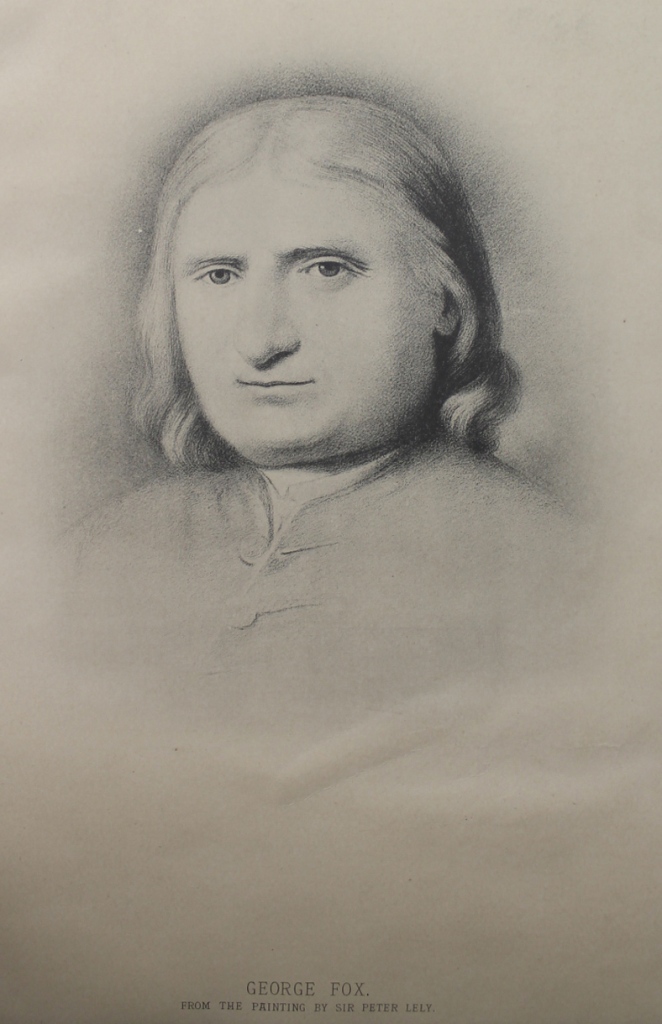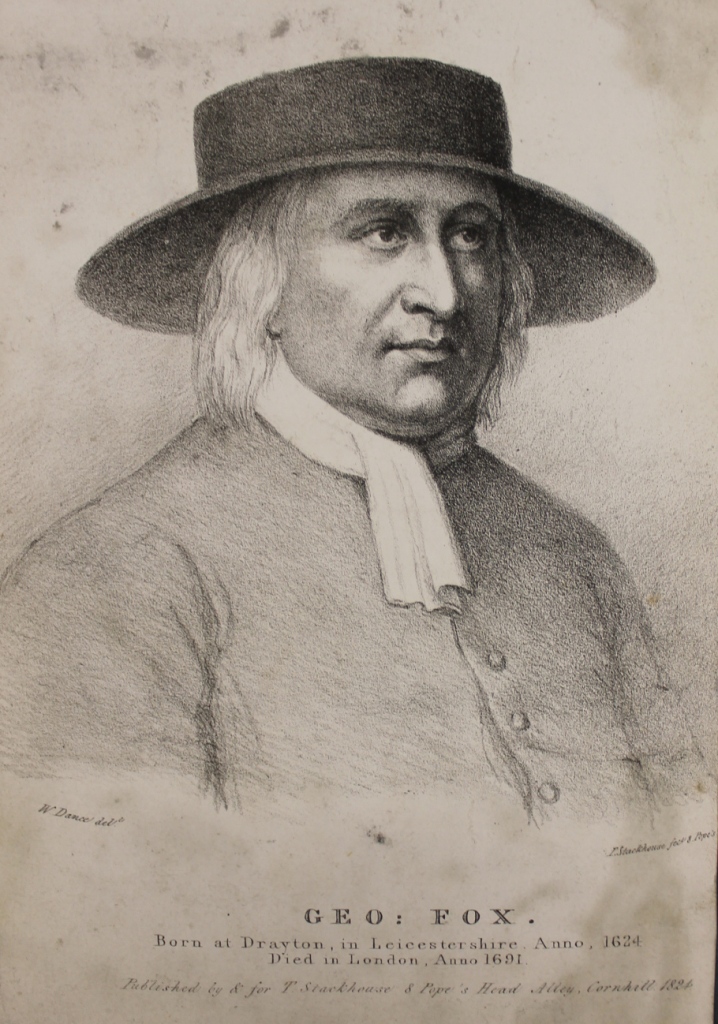George Fox (1624-1691) was born in Leicestershire and is one of the founding figures of Quakerism.
Our Library & Archive collections hold many portraits of George Fox, most produced throughout the 19th and 20th centuries. None of the portraits can be authenticated as being made during Fox’s life. Most critics do not think he would have the time or patience to have sat for a portrait. Quakers focussed on concrete forms of expression in writing and preaching. They were avid and prolific publishers of Christian doctrine who travelled extensively.
Regardless, portraits of George Fox and other influential Quakers were made after their deaths because there was a demand and they sold well.
One of the first dedicated books critiquing Quaker portraiture is Wilfred Whitten’s Quaker Pictures, first published in 1897. It is a useful book to refer to though many assertions are from a personal perspective and without reference. One of the portraits Whitten refers to is an oddly interesting picture that shows the moment George Fox aged 30 became enlightened. George Fox, Ætat. 30, a stipple engraving by James Holmes based on the painting by Gerard Honthorst, was published in 1799.

This engraving was published by Quaker bookseller Thomas Clio Rickman (1761–1834), who at the time owned the 1654 oil painting by Honthorst on which the print is based. In 1932, National Portrait Gallery responded to a query from our then Librarian, confirming that Honthorst was only in England in 1628, when George Fox was only four years old. So he could not have painted him from life! The date of 1654 assigned on the print is questionable. The NPG confirmed that the painting was exhibited in the National Portrait Exhibition of 1866.
Paintings by Dutch artist, Egbert van Heemskerck (1634–1704) are known for satirical scenes of everyday people often in caricature poses. One example is, ‘A Quaker Meeting’ which depicts a gesticulating woman preaching in a dark dowdy space with most people looking indifferent or laughing at her. Many prints were made from this painting and sold as anti-Quaker.


In William Hull’s article, Heemskerck’s Quaker Meeting, he suggests that George Fox and other known Quakers could have been depicted in this painting made circa 1685. Fox did spend several months in the Netherlands as Quakerism was received positively with a Yearly Meeting set up in Amsterdam. The John Bowles published engraving that Hull refers to shows ‘George Fox’ leaning and listening to the woman preaching. There is little evidence to confirm his identity and this print edition Hull refers to was made circa 1723.
For many years, the enigmatic portrait of George Fox attributed to Sir Peter Lely was thought to have been painted in Fox’s lifetime. The painting was bought in 1858 at an antique shop in London by John Wethered, an American congressman. The name Geo Fox written on the back of the canvas was apparently inscribed many years later.

After Wethered’s death, the portrait was donated to Swarthmore College where it currently resides. In a letter dated 1931 written by Alfred M. Brooks, professor of Fine Arts at Swarthmore College, the painting was authenticated as not being the work of Lely. It is another artistic representation of George Fox (allegedly) and in any case not painted in his lifetime.
In 1923, Library acquired an oil painting entitled Geo Fox, first Quaker which is painted in red on the canvas, located bottom right corner. This was not Fox at all, but John West (1690-1776), father of the artist Benjamin West (1738- 1820) who painted it. John West did become a Quaker later in life in 1759. This lovely portrait was painted circa 1765 and shows West’s father in typical 18th century Quaker male clothing. This is another example of how someone inscribed the name of George Fox on the canvas in order to sell it.

I have always liked a little woodcut of George Fox and was sad to find that it was from the 19th century not 17th. In correspondence files from 1994, it was confirmed that the small portrait was printed and donated by Joseph Smith (1819-1896). According to a note in the Library’s MS Portfolio 20, describing its (unknown) origin, this ‘rude woodcut’ is believed to have been printed in ‘some publication’ during Fox’s lifetime. Sadly we do not know the name and date of the publication but nevertheless, this woodcut seems to have been influential in the evolution of Fox’s image, as the note suggests three prints were derived from this “17th century” portrait.

The first of these portraits was published in 1822. The artist is unknown but in relation to the woodcut, has a similar pose though sitter is looking left and the hat is turned up.
The second is a lithograph drawn by William Dance published by Thomas Stackhouse in 1824, with deep set eyes and hat similar to the woodcut.
The third is engraved and published by Samuel Allen after a painting by Samuel Chinn sold by Harvey & Darton, 1838, with a thinner face and stature and, dare I say it, looking rather like the Quaker Oats logo (though their logo wasn’t created until 1877 and borrowed heavily from well-known published engravings of William Penn). This rendition of GF is artistically better executed than the woodcut and some other previous versions.



Searching online, there are many more similar portraits all depicting an older man with shoulder length grey hair wearing a wide brim hat and cravat. Many of these variations of ‘George Fox’ seem to come from a lithograph drawn by Thomas Fairland, published by William Darton & Son circa 1830s. It adds to a long list of portraits in circulation, printed by various publishers, all borrowing heavily from each other on pose, dress and style.


The main publisher for these prints was Quaker William Darton (1755-1819) who began his business in 1787 as a printer, engraver and book publisher in London under W. Darton & Co. then partnership with another Quaker, Joseph Harvey (1764-1841), setting up the firm of Darton & Harvey.
Turning briefly to sculpture, the library has an imposing bronze bust of George Fox by Sir Alfred Turner (1874-1940). Donated to the Library in 1906, Turner based the bust on numerous portraits of GF and the death mask of Oliver Cromwell to create a sense of strength and dignity. The bust was commissioned by the donor and was created in 1901.

Quaker painter and print maker, Robert Spence (1871-1964), took it upon himself to illustrate George Fox’s Journal. Born in Tynemouth, son of the artist Charles Spence, he studied in Newcastle, at Slade School of Fine Art and in Paris. His father was a great collector of Quaker material and had inherited the Spence Collection of manuscripts, which includes the hand written manuscript of George Fox’s Journal and other works by early Friends. When this manuscript was rebound, the first six pages are dedicated to the various published portraits of George Fox!
Spence’s etchings show scenes described in George Fox’s Journal, and were created over a number of years with the earliest in 1892, the latest in 1954. His portrait of George Fox at Swarthmoor Hall, made in 1950, was used for the front cover of revised edition of The Journal of George Fox by John L. Nickalls, 1997 printing.

The ongoing curiosity of what George Fox looked like continues into the 21st century. On the cover of The Friend (28 April 2023), artificial intelligence tool, Open Art generated a portrait with the prompt ‘George Fox age 28 wearing hat, standing on Pendle Hill in a modern painting’. The result was a composite of all the George Fox’s portraits currently circulating on the Internet. After looking at countless GF’s as a middle aged man, it is fascinating to see an artistic representation of a younger man.
As the centuries pass and artistic styles change, the continuing evolution of George Fox’s portrait will too. There is nothing wrong in an attempt to visualise an influential enigmatic Friend whose charisma and teaching had such a profound effect on the spiritual growth of Quakerism.
Melissa Atkinson, Special Collections Curator

References:
Nickalls, John, Some Quaker Portraits Certain and Uncertain,
London : Friends Historical Society ; Philadelphia, Pa. : Friends Historical Association, 1958 pages 7-9
Whitten, Wilfred, Quaker Pictures [first series]
London : Headley Brothers, ; 1897, pages 1-7
Punshon, John, Portrait in Grey: a short history of the Quakers
London : Society of Friends. London Yearly Meeting. Quaker Home Service, 1984. page 38
Hull, William ‘Heemskerck’s Quaker Meeting’. In Bulletin of Friends Historical Association Philadelphia, vol. 27 (Spring 1938), pages 17-58
Von Effra, Helmut and Staley, Allen The Paintings of Benjamin West
London: Yale University Press 1986, page 461
The Quaker Meeting by Egbert van Heemskerck on the Royal Collection website, https://www.rct.uk/collection/402980/the-quaker-meeting
The Quaker’s Meeting after Egbert van Heemskerck published by John Bowles, c1723-1768. On the British Museum website: https://www.britishmuseum.org/collection/object/P_1871-0211-18
The Friend 28 April 2023, volume 181, no. 17 The Friend Publications Ltd., front cover and page 15
LSF Portfolio 20/145 note from Joseph Smith, transcribed by J. Lewellyn Curtis, circa 1890
LSF MS Box 5_18 letter from Alfred M. Brooks Swarthmore College re: Lely painting, dated November 27, 1931
LSF MS BOX V2_4 letter from Burlington Galleries re: Honthorst painting, dated February 9th, 1914
LSF MS Box 6_17 letter from National Portrait Gallery re: Honthorst painting and print, September 27th 1932

Thank you!
Judy Cox Whipple
David Woolgrove recruited a local artist, Margaret Peach of Kelso in the Scottish Borders, to paint a new portrait of George Fox based on the well known painting by S Chinn as the front cover of his reprint of Jospeh Pickvance’s “A reader’s Companion to George Fox’s Journal” Curlew Productions, Kelso in 1989. David was proud that he had managed to put a smile on George Fox’s face.
Alastair Reid alastairhreid@gmail.com
>
I looked for S Chiinn and found this picture as attributed to S. Allen” (published 1838) of a painting by “S. Chinn”. The provenance of the original painting is unknown.
Alastair alastairhreid@gmail.com
>
This was a wonderful, informative article and treat to read. Thank you for your scholarship and sharing.
This superb, thank you so much!